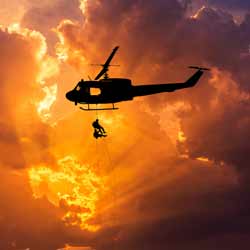Helibase and Helirappeller Jobs
A Helirappeller is a lot like a smokejumper and is a position that requires similar training and experience. Helirappellers work in teams from two to twelve in high-risk fire zones. When there is a remote fire, or a fire requires a quick response, helirappellers fly to the hot zone and assess the fire.

The Helirappel team is meant to be the quickest mode of response to a fire region and is often times the first line of defense against the spread of a large wildfire. If there is no place for the aerial crew to land, helirappellers rappel out of the hovering aircraft into the fire zone. Once on land, the heli crew acts as any other attack firefighter, implementing methods to sustain and putout fires. Some fires can take days to putout and helirappellers enter fire zones with enough equipment and sufficient survival skills to last them for days. Once the fire is under control, the crews hike out of the fire zone and back to their Helibase, or closest land base.
Helirappellers operate out of their own Helibase, a landing zone and base camp used for the maintenance of the aircraft, a home base for rappellers, training facility and communications post for that specific crew. Helibases are typically smaller in size than regular land bases, with crewmembers ranging from 20 – 30 rappellers. Among these rappellers are senior and seasonal-only rappellers. Also included in the base camp are base managers and lead crewmembers. Positions such as base managers usually have years of experience in the field and are professionally trained firefighters, fire planners or ex-rappellers.
Seasonal Work
Helirappelling, like other firefighting work is mostly seasonal.
There are some helirappellers that stay on permanently, but since forest fires occur seasonally, helirappellers and helibase workers are employed primarily during the fire season (May – October).
Helirappeller Training
The training period for a seasonal Helirappeller begins in early May. This is usually followed by a month-long intensive period of hands on fire and aviation training. It includes proper certifications, first aid education, survival training and training in the proper use of fire suppression tools and techniques. There are rigorous physical fitness tests and exercises that must be passed in order to be approved for dispatch into a fire zone as a helirappeller.
Fitness
The US Forest Fire and Aviation Management bureau considers fitness an integral part of a firefighter’s training. Because working conditions can be intense and fire equipment is heavy, all fitness tests must be completed before a helirappeller will be allowed in the field.
Specific requirements are listed as:
- 1.5 mile run in 11:00 min or less
- 20 pushups in a minute
- 5 full extension pushups
- 85 lbs. pack test over different terrain
- 45 lbs. work capacity test
Requirements and Recruitment
Helirappel teams usually take on 5-10 new rappellers each year. A helirappeller is expected to have at least two years of previous fire fighting experience. Workers must be able to complete tasks under stressful and intense work environments and work well with others. Personality types are very important for a firefighter and helirappeller because members of a fire crew must work well as a team.
Getting Hired
Hiring usually begins in February and ends in March. Researching National Parks and Firefighting programs in your area will have links to information regarding heilrappelling. Most commonly, these programs are found in the western states and high-risk fire zones. Below is a list of links to specific Helibase and Helitack crews complete with contact information and requirements for Helibase and Helirappelling applicants.

